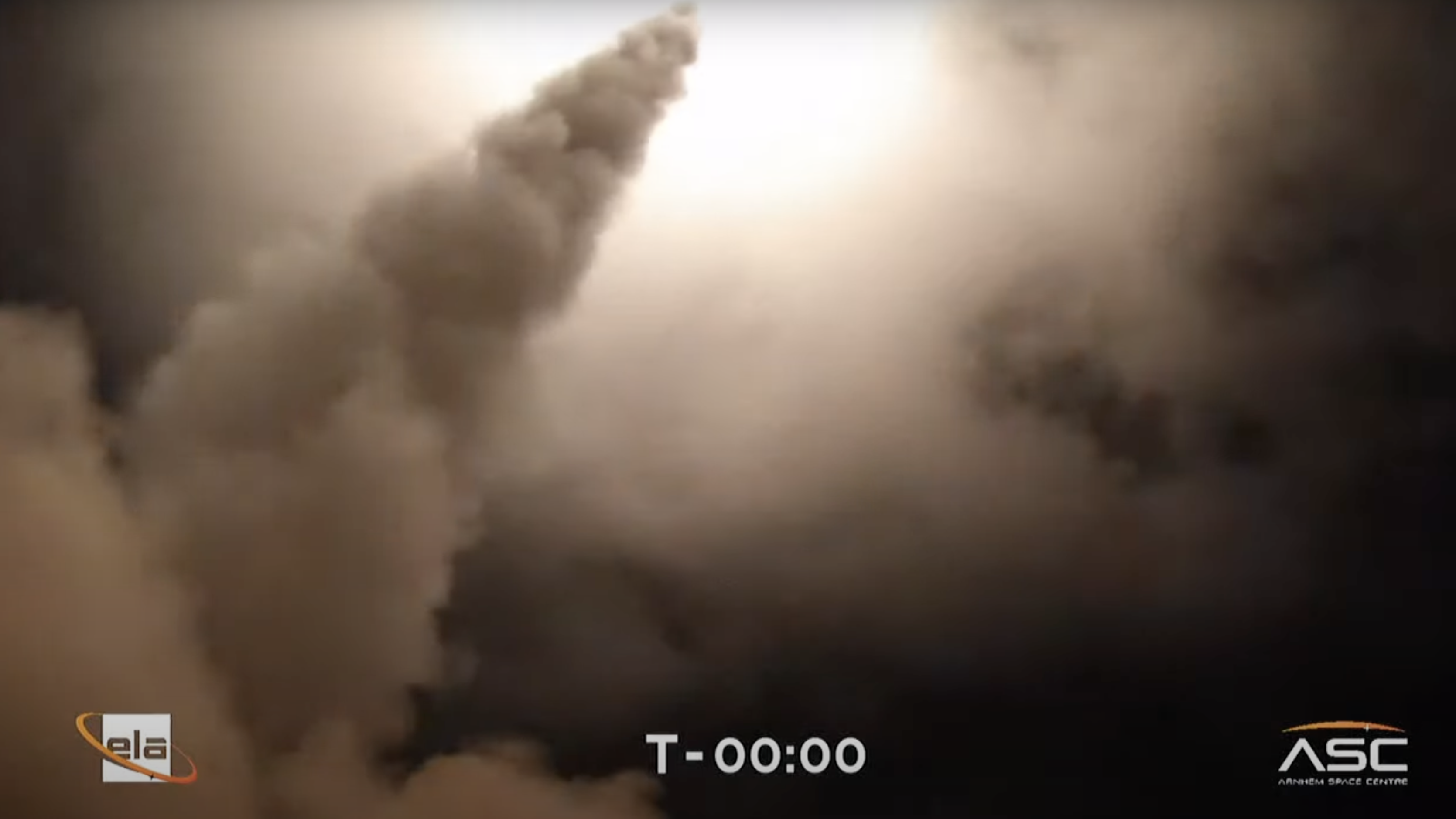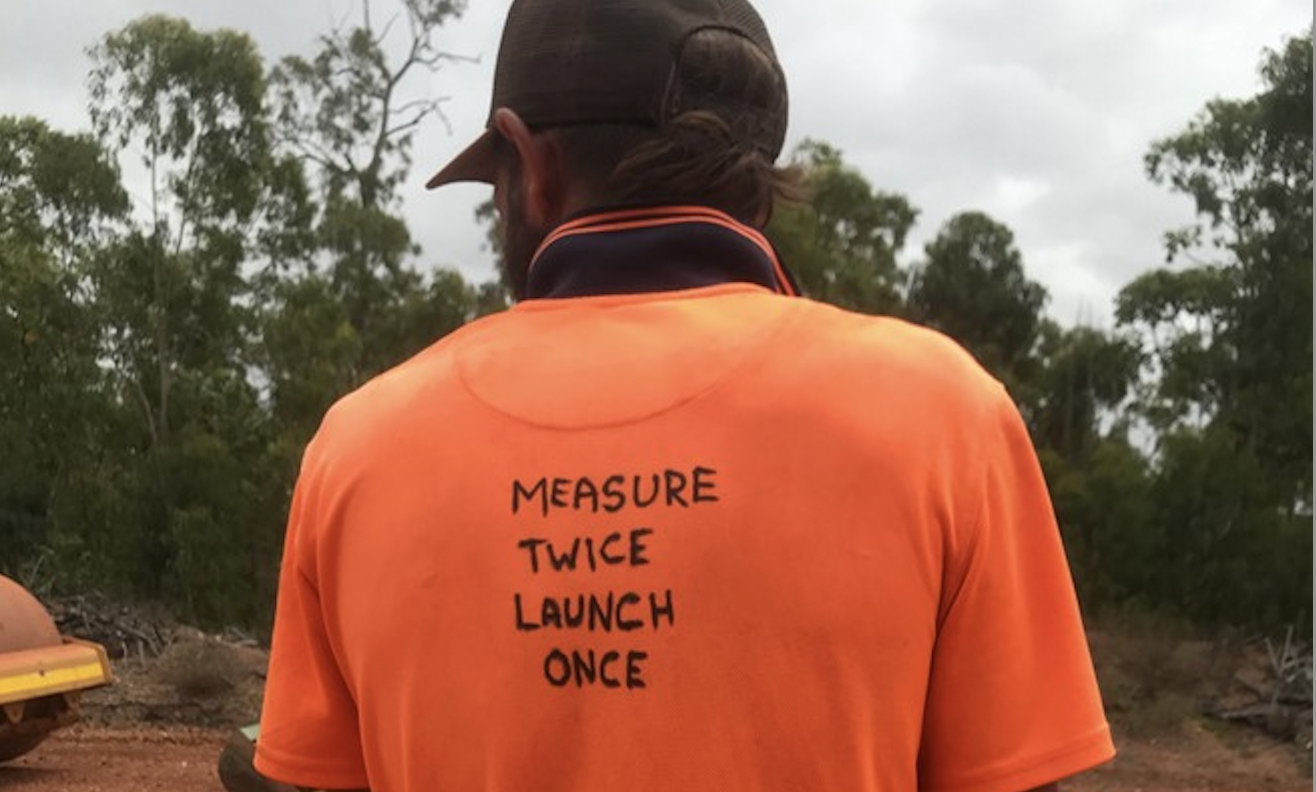
29 May, 2024 | Media Releases
ELA announced as ‘Launch Business of the Year’ in the AusSpace24 Australian Space Awards.
Equatorial Launch Australia has been awarded ‘Launch Business of the Year’ at the AusSpace24 Australian Space Awards at a gala event held in Sydney on Tuesday night.
The judging panel cited ELA’s innovative business strategy, advanced technological offering and the support from its customers and partners as key elements in the decision to present the award to the spaceport operator. ELA’s progress in developing a nationally significant infrastructure project for sovereign space launch capability for Australia was also key to the judging panel’s decision.
Speaking after accepting the award, ELA’s Group CEO Michael Jones said that the honour further endorsed ELA’s value proposition in its innovative approach to launch services and access to space.
“I’m thrilled to accept this award for Launch Business of the Year on behalf of the ELA team. This award acknowledges the hard work of our entire team over the past few years in redeveloping the Arnhem Space Centre into the Spaceport of the Future. It’s our aim to be the pre-eminent multi-user commercial spaceport globally. Our ‘Resident Launcher’ business model and high-tech launch pads and integration facilities have resonated with our customers and this award underscores that and reflects that we are well on our way to achieving our goals.’
Mr Jones also added that the support of partners and customers reinforced the success.
“Space is hard. To be successful in the space sector there are a lot of hurdles to clear and its only with a high performing team and with the support of our partners and customers that we can be successful. I would like to express my thanks to them,’ he said.
ELA successfully launched with NASA in 2022 and has since been undertaking a redevelopment of the Arnhem Space Centre into a high tech, multi-user commercial spaceport. The redevelopment aims to simultaneously deliver a critical space infrastructure project for sovereign launch capability and help to relieve spaceport congestion worldwide, whilst also planning for future launcher needs to deliver a state-of-the-art launch services facility with a planned increasing launch cadence to more than 50 launches per year. First orbital launches from the spaceport are planned to commence in 2025 with South Korean launch vehicle provider Innospace.
The AusSpace Australian Space Awards celebrates exceptional achievements in the space sector and is widely accepted as the benchmark for excellence in the emerging field of space. Recognising the leading individuals and businesses driving the development of Australia’s space economy, the AusSpace Awards universally acknowledges all space industry stakeholders driving innovation and accelerating the industry to new heights.
The Awards program is run in conjunction with the AusSpace24 Australian Space Summit and Exhibition being held in Sydney on 28 & 29 May 2024. Mr Jones is delivering a keynote address and participating in a panel session during the Summit before heading to Singapore to speak at Asia Satellite Business Week on 30 May 2024.
For a full list of the winners and finalists visit the Australian Space Awards page here.

11 July, 2022 | ELA Update, Launch information, Media Releases |
Equatorial Launch Australia (ELA) the developer, owner and operator of the Arnhem Space Centre (ASC) in Australia’s Northern Territory today successfully completed its third launch with NASA – the third launch in 15 days.
The NASA DEUCE mission will help astronomers measure an unstudied part of Centauri A and B’s ultraviolet light spectrum, helping them model stars and understand their effects on planetary atmospheres.
Michael Jones, Executive Chairman and Group CEO of ELA, said the successful launch was a great finale to the NASA campaign – consisting of three separate launches – that began on June 26.
“We are really proud to have achieved a very rare feat – three successful launches in just 15 days. Even more so given the challenging wind conditions,” Mr Jones said.
“We are also very pleased that the scientists involved with these launches are very happy with the results of the experiments,” Mr Jones added.
“Another successful launch at the Arnhem Space Centre further strengthens our team and builds the capability of the Australian space industry,” said Mr Jones.
“These missions with NASA have been an incredible chance to prove the capabilities of our team and facility and we are looking forward to welcoming more partners to the site.”
More information about the mission is available here.

27 June, 2022 | Media Releases |
Equatorial Launch Australia (ELA) the developer, owner and operator of the Arnhem Space Centre (ASC) on the Gove Peninsula in Australia’s Northern Territory today successfully completed Australia’s first commercial space launch with NASA.
The historic launch was NASA’s first from a fully commercial spaceport and is the first of three rocket launches, with the latter two planned for 4 and 12 July, to conduct astrophysics studies that can only be done from the Southern Hemisphere.
The Arnhem Space Centre is the only commercially owned and run multi-user equatorial launch site in the world and is located 12 degrees south of the Equator on the Gulf of Carpentaria offering unique benefits for space launches. ASC is also unique as most spaceports are federal/government owned/operated facilities.
Witnessing the launch at the Arnhem Space Centre tonight were the Chief Minister Natasha Fyles, Consul General of the United States Kathleen Lively, senior members of the Australian Space Agency and the space industry, Traditional Owners, the Northern Territory Government, stakeholders and supporters of ELA.
Michael Jones, Executive Chairman and Group CEO of ELA, said it was a historic night for ELA as it celebrated the first of many successful launches to happen at the Arnhem Space Centre.
“We are delighted to announce the successful completion of our first commercial space launch with our customer, NASA,” said Mr Jones.
“In the lead up to the launch, I was consistently asked if I was excited. I can officially now say, I’m excited. I’m excited both about the success of our launch but also for the future of ELA and the Australian space industry.
“We could never have dreamed of having such a supportive, experienced and professional partner as NASA. They have been unbelievably generous in helping us through this journey and we will be a much better organisation for their support.
“Today’s launch not only puts ELA at the forefront of global commercial space launch, it also confirms that we and Australia can provide access to space and this is just the beginning for us.
“It is a tremendous honour to celebrate the success of this milestone launch with NASA and everyone here at the Arnhem Space Centre will now refocus to ensure the success of the next two launches in July.
“Previously I’ve acknowledged the support of NASA, our investors, including the NorthernTerritory Government, but tonight I’d like to take the opportunity to thank my staff and the board of ELA for making this a reality.
Today, we have achieved a remarkable feat and made a huge mark in the history of Australia’s journey in space,” Mr Jones said.
Today’s launch took place at 12:00am (ACST) and saw a BBIX rocket travel over 300 kmsin space, carrying an atmospheric observation/sensing platform to observe the AlphaCentauri A & B constellations.

8 June, 2022 | Media Releases |
As the developer, owner and operator of the Arnhem Space Centre (ASC) on the Gove Peninsula in Australia’s Northern Territory today we’re excited to announce that our client, NASA, will be making Australia’s first commercial space launch on the evening of Sunday 26 June 2022.
The historic launch is also NASA’s first launch from a fully commercial spaceport and will be one of three rocket launches, with the others planned for 4 and 12 July, to conduct astrophysics studies that can only be done from the Southern Hemisphere.
The Arnhem Space Centre is the only commercially owned and run multi-user equatorial launch site in the world and is located 12 degrees south of the equator on the Gulf of Carpentaria offering unique benefits for space launches. ASC is also unique as most spaceports are federal/government owned/operated facilities.
Michael Jones, Executive Chairman and Group CEO of ELA said that whilst these historic NASA launches were a huge milestone for ELA, the company was already looking to the future beyond milestone campaign.
“Having NASA as our first customer is not only a great endorsement of our spaceport, but it places us at the forefront of global commercial space and proves that through ELA and the ASC, Australia now has a Sovereign launch capability and access to space,” Mr Jones said.
“It is a tremendous honour and reward for the hard work our company has carried out in developing the ASC to have NASA launch these three missions with us”.
“This campaign is just the start for us as we are in advance commercial discussions with nine other major rocket companies, and we hope to carry out at least two additional launches in 2022 before ramping up our launch cadence to over 50 launches per year by 2024/25,” Mr Jones said.
ELA and the Arnhem Space Centre were recently awarded their Launch Facilities Licence and the Launch Permit for the NASA campaign following a two-year evaluation by the Australian Space Agency.
“The three NASA launches marks the end of the first stage of the development of both the ASC spaceport and ELA as a world class launch services company. We will now commence the development of Phase 2 of the ASC which includes the construction of additional larger launch pads to accommodate medium sized/larger payload rockets,” Mr Jones said.
“The geographic location, proximity to the equator and the extensive logistics services offered on the Gove/Nhulunbuy area makes the ASC very attractive to global rocket companies and allows us to provide a commercially attractive alternative to the French government’s Kourou equatorial launch site in French Guiana,” Mr Jones continued.
“The ASC offers Australian space businesses and international rocket and satellite companies a unique opportunity to launch from a site which provides cost effective access to virtually any orbit they desire,” Mr Jones said.
“I really want to acknowledge the support of not only NASA, but our staff and investors, including the Northern Territory Government for their support and dedication. It is a remarkable achievement what we have done and all the more so, given we have had no Federal Government support to date. We haven’t made bold predictions in the past, we just quietly went about our work and now we are set to achieve a couple of incredible firsts in the space history of Australia,” Mr Jones said.
Launch Mission – Background Information
The launch will take place in the late evening of 26 June 2022 and the BBIX rocket will travel to over 300KMs in space. The Rocket will carry an atmospheric observation/sensing platform to observe the Alpha Centauri A & B constellations. The rockets’ first stage and payload will return to earth and be recovered. The rockets will be visible to the local community and surrounding areas from only seconds after liftoff – about 150 metres into the sky until just prior to it exiting the earth’s atmosphere.
For safety reasons, no close proximity public viewing of the rocket launching from the ASC will be possible.
Ends
Images, interviews and B-roll vision available for download from: https://elaspace.box.com/s/mc3za2yacf65n31c75ypc3z4wls7jimu




